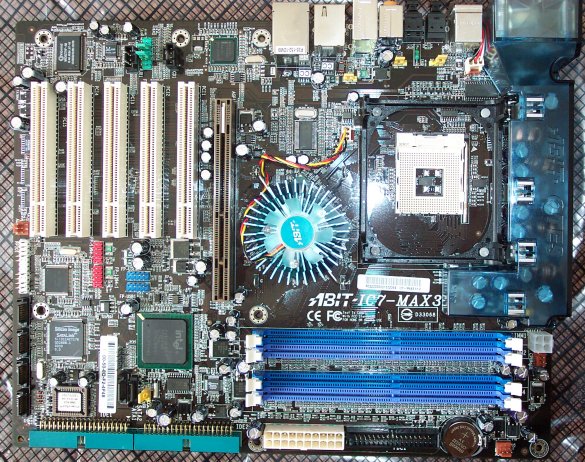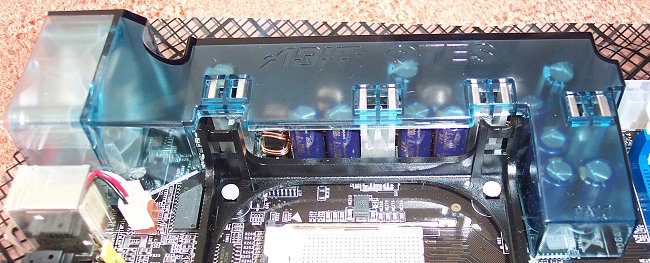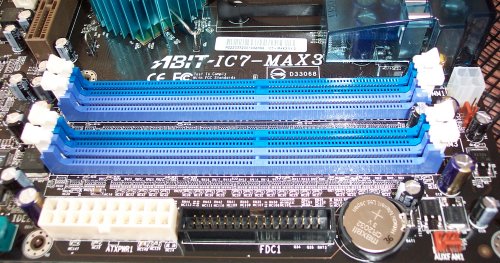Layout and features

First appearances give off the impression of a cluttered, unwieldy board. Appearances can be deceiving, though. Attention is almost immediately focussed on the unusual-looking addition to the right of the CPU socket. That's the OTES cooling system that's new on this model, folks.

We mentioned that the IC7-MAX3 had one of the most unusual I/O shields that we'd come across. The explanation lies with the small fan that takes the place of the PS/2 ports in most motherboards. High frequency running generates heat; lots of it. MSI recently began placing heatsinks on its prestige boards' MOSFETs. The 'sinks were hot to the touch, suggesting that the MOSFETs were really kicking out some serious finger-scorching heat. Most enthusiasts aren't content with a mere 200FSB speed. 250FSB+ is now the norm for a decent i865PE or i875P motherboard, so the power delivery, with due respect to increased voltages, needs to be clean and consistent. ABIT thinks that in providing localised heat removal, on top of MOSFET heatsinks, for the components most under strain as the board is pushed to the ragged limit will aid in providing higher overclocks than a non-OTES-cooled motherboard. We'd love some thermal imaging shots that highlighted whether the OTES system was successful in its job or not, but we can confirm that a steady flow of warm air was exiting out of the back of the PC. Thankfully, the fan was barely noticeable above the general noise emitted by the PC. It seems like a good idea on principle, and the plastic surround has the requisite screws to secure it in to a case. Another nifty feature are the green LEDs that shine when the board is operational. Definitely one for the modding crowd.


Moving along to the 4 DDR slots. Two of the board's five fan headers are taken up by the OTES and North Bridge fans, so we're left with three, two of which are located in and around the DIMM slots. Wouldn't it also be great if the OTES system was extended to remove the heat from system RAM at the same time?. There's a thought. One area of good design is in the cable routing. The standard 20-pin power connector, 4-pin CPU connector, floppy, IDE and SATA ports are all arranged down one side. That gives the PC a cleaner look and keeps cabling out of the way of fans' airflow. The dual-channel nature of the board means that it'll run best with two modules of equal size. ABIT highlights the slots necessary for DC running.

The original IC7-MAX series of boards were often criticised for having a noisy North Bridge cooler. The one supplied with the MAX3 is an order of magnitude quieter than the IC7-G's we reviewed some time ago. The space between it and the P4 retention bracket is a little limited but shouldn't cause too many problems with CPU coolers of a reasonable size. Everything seems a little cramped, solely because the OTES cooling pushes the CPU socket a little further down the board than normal.

If the right-hand side is all about cooling and overclocking, the left-hand side is all about storage and features. ABIT may bundle in a SecureIDE security device, but the board just screams SATA. Intel's flexible ICH5R South Bridge provides a couple of on-chip ports that can be configured for independent and RAID running. It even allows the user to add a second SATA RAID-forming drive if it's setup correctly initially. A couple of USB headers that take the maximum to the permitted 8 and the handy extended CMOS jumper surround the S.B. Due to a lack of space or for appearance's sake, ABIT chooses to rotate the two standard IDE ports. Note that there's no provision for IDE RAID on this motherboard.

A little further down is where the real SATA fun starts. We're used to seeing the Silicon Image Si3112 2-port PCI-based SATA controller on high-end motherboards. ABIT goes a step further with the Sil3114 controller. Can you guess the difference from the name ?. Yup, there's now 4 ATA150 SATA ports. That's an awful lot of potential bandwidth riding on the PCI bus. FireWire connectivity, in the form of a Texas Instruments controller and 3 ports, sits to the left. The combined bandwidth requirements of the SATA and FireWire controllers will make any PCI bus cry, especially if used concurrently. The controller has the ability to run in standard, independent modes, RAID0, RAID1 and RAID0+1. It's questionable if you'll ever need to run 6 SATA drives from a consumer P4 board. Settings are inputted in a pre-OS bootup screen. It's all intuitively easy to comprehend.

High-speed connectivity and SATA ports place a burden on the PCI bus. ABIT has chosen wisely to add Gigabit Ethernet ability via Intel's 82547EI fifth-generation Gigabit controller and a dedicated CSA link to the North Bridge. Adding a PCI-based Gigabit controller would have really swamped the bus. The OTES cooling system forces ABIT into ditching one PCI slot; that's no problem with the level of integration present on the board. Sound is trusted to Realtek's ALC650 CODEC, which offers S/PDIF connectivity (found on the back panel). The all-new auto jack-sensing ALC658 is now out, it's a shame not to see it on the MAX3.

Perhaps the most unusual I/O panel you'll see this year ?. The fan is what makes the OTES system tick, and it's not particularly annoying, either. PS/2 ports, optical In and Out, 6-channel sound, 4 USB2.0, a 6-pin FireWire port and an RJ45 socket for the Gigabit LAN make it an I/O panel worthy of a high-end board. The bundled brackets and on-board ports will still omit 2 USB2.0 and a single FireWire port. ABIT's Media XP module is compatible with the MAX3 and should give the user the full complement of options and extras.









